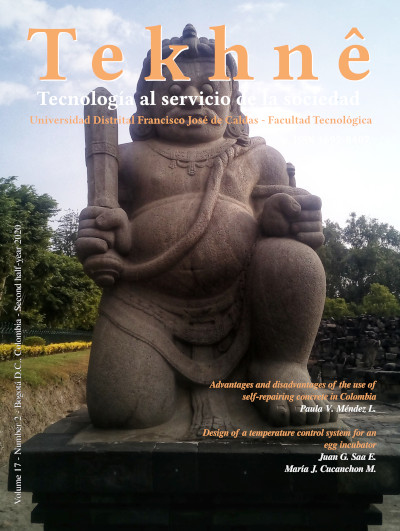Published:
2020-12-25Issue:
Vol. 17 No. 2 (2020): Tekhnê JournalSection:
ArticlesDesign of a temperature control system for an egg incubator
Diseño de un sistema de control de temperatura para una incubadora de huevos
Keywords:
Control, eggs, incubator, PID, stability, temperature (en).Keywords:
Control, estabilidad, huevos, incubadora, PID, temperatura (es).Downloads
Abstract (en)
In general, an egg incubator is used to increase the productivity of poultry egg incubation. This tool develops a set of important variables that influence the incubation process for successful hatching, one of these variables is temperature. In order to increase the percentage of hatchability of the system, it is necessary to be able to guarantee temperature stability. This article will address the problem of temperature control in a hen egg incubator, which is key to obtaining baby chicks in optimal conditions. Using the PID control system, the aim is to provide a solution to the temperature variation that occurs in the incubation process. Thus, the purpose of this article is to design a temperature control system based on mathematical calculations using experimental data.
Abstract (es)
En general, una incubadora de huevos se utiliza para aumentar la productividad de la incubación de huevos de aves de corral. Esta herramienta desarrolla un conjunto de variables importantes que influyen en el proceso de incubación para una eclosión exitosa, una de estas variables es la temperatura. Para elevar el porcentaje de incubabilidad del sistema, este requiere poder garantizar una estabilidad en la temperatura. En este artículo se abordará el problema del control de la temperatura en una incubadora de huevos de gallina, que es clave para la obtención de pollos bebé en óptimas condiciones. Utilizando el sistema de control PID se busca aportar una solución a la variación de temperatura que se presenta en el proceso de incubación. Así pues, la finalidad de este artículo es diseñar un sistema de control de temperatura a partir de cálculos matemáticos tomando como base datos experimentales.
References
Åström, K., & Hägglund, T. (2010). The future of pid control. Elsevier Science, 9(12), 1163–1175. https://doi.org/https://doi.org/10.1016/S0967-0661(01)00062-4
Han, J. (2010). From pid to active disturbance rejection control. IEEE Transactions on Industrial Electronics, 56(10479737), 900–906. https://doi.org/10.1109/TIE.2008.2011621
Martínez, C., & Josmell, L. (2015). Control de temperatura de una incubadora microbiológica, utilizando un controlador pid. Acceso Libre a Información Científica para la Innovación.
Martínez, F., & Acero, D. (2020). Pid controller tuning using bacterial quorum sensing (qs). Tecnura, 24(64), 13–22.
Ogata, K. (1998). Ingeniería de control moderna. PEARSON PRENTINCE HALL, (970-17-0048-1).
Shafiudin, S., & Kholis, N. (2018). Monitoring system and temperature controlling on pid based poultry hatching incubator. Institute of Physics Publishing, 336(012007), 6053–6087.
Sharawi, A. R. S. ; S. M. E.-M. ; M. M. F. ; A. A. (2013). Pid and fuzzy logic optimized control for temperature in infant incubators. 2013 5th International Conference on Modelling, Identification and Control (ICMIC), Cairo, 201, 53–59.
Utama, Y. A. K., & Hari, Y. (2017). Design of pid disturbance observer for temperature control on room heating system. 2017 4th International Conference on Electrical Engineering, Computer Science and Informatics (EECSI), (17452839), 1–6. https://doi.org/10.1109/EECSI.2017.8239171
Widhiada, W., Antara, I., Budiarsa, I., & Karohika, I. (2019). The robust pid control system of temperature stability and humidity on infant incubator based on arduino at mega 2560. Institute of Physics Publishing, 248(012046), 6053–6087.
Zhenlong Wu, D. L., & Wang, L. (2016). Control of the superheated steam temperature: A comparison study between pid and fractional order pid controller. 2016 35th Chinese Control Conference (CCC), (16265348), 10521–10526. https://doi.org/10.1109/ChiCC.2016.7555024
Zhigang Wang, X. L., & Lu, X. (2017). Temperature control based on a single neuron pid algorithm for a blackbody radiation source. IEEE International Conference on Mechatronics and Automation (ICMA), (17137435). https://doi. org/10.1109/ICMA.2017.8015817
How to Cite
APA
ACM
ACS
ABNT
Chicago
Harvard
IEEE
MLA
Turabian
Vancouver
Download Citation
Visitas
Downloads
License
Copyright (c) 2020 Juan G. Saa E., María J. Cucanchon M.

This work is licensed under a Creative Commons Attribution-NonCommercial-NoDerivatives 4.0 International License.
Those authors who have published with this journal agree to the following terms:
- The authors retain their copyright and guarantee to the journal right of first publication of his work, which will be simultaneously subject to license recognition of Creative Commons that allows others to share the work as long as its author is indicated and its first publication in this journal.
- Authors may adopt other agreements nonexclusive distribution version of the work as long as indicated that the initial publication is in this journal.
- It allows and encourages authors disseminate their work via the Internet before and during the submission process, which can produce interesting exchanges and increase citations of the published work.


